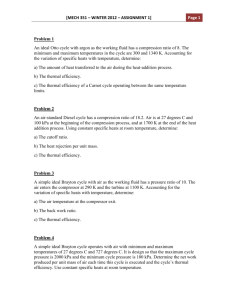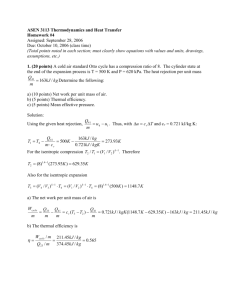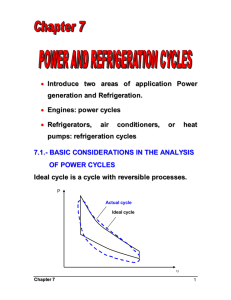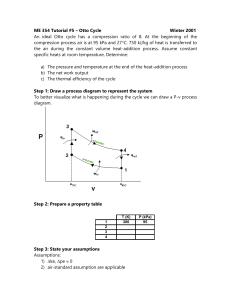Chapter 9 Gas Power Cycles
advertisement
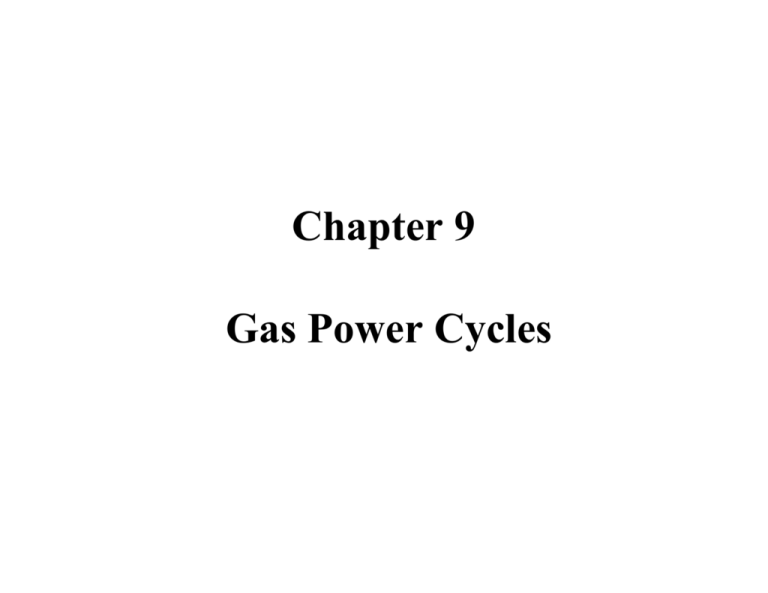
Chapter 9 Gas Power Cycles Our study of gas power cycles will involve the study of those heat engines in which the working fluid remains in the gaseous state throughout the cycle. We often study the ideal cycle in which internal irreversibilities and complexities (the actual intake of air and fuel, the actual combustion process, and the exhaust of products of combustion among others) are removed. We will be concerned with how the major parameters of the cycle affect the performance of heat engines. The performance is often measured in terms of the cycle efficiency. Wnet η th = Qin 2 Carnot Cycle The Carnot cycle was introduced in Chapter 5 as the most efficient heat engine that can operate between two fixed temperatures TH and TL. The Carnot cycle is described by the following four processes. Process 1-2 2-3 3-4 4-1 Description Isothermal heat addition Isentropic expansion Isothermal heat rejection Isentropic compression 3 Note the processes on both the P-v and T-s diagrams. The areas under the process curves on the P-v diagram represent the work done for closed systems. The net cycle work done is the area enclosed by the cycle on the P-v diagram. The areas under the process curves on the T-s diagram represent the heat transfer for the processes. The net heat added to the cycle is the area that is enclosed by the cycle on the T-s diagram. For a cycle we know Wnet = Qnet; therefore, the areas enclosed on the P-v and T-s diagrams are equal. 4 Thus or since 5 We often use the Carnot efficiency as a means to think about ways to improve the cycle efficiency of actual cycles. One of the observations about the efficiency of both ideal and actual cycles comes from the Carnot efficiency. Thermal efficiency increases with an increase in the average temperature at which heat is supplied to the system or with a decrease in the average temperature at which heat is rejected from the system. η th , Carnot TL = 1− TH 6 Air-Standard Assumptions In our study of gas power cycles, we assume that the working fluid is air, and the air undergoes a thermodynamic cycle even though the working fluid in the actual power system does not undergo a cycle. To simplify the analysis, we approximate the cycles with the following assumptions: 1.) The air continuously circulates in a closed loop and always behaves as an ideal gas. 2.) All the processes that make up the cycle are internally reversible. 3.) The combustion process is replaced by a heat-addition process from an external source. 4.) A heat rejection process that restores the working fluid to its initial state replaces the exhaust process. 5.) The cold-air-standard assumptions apply when the working fluid is air and has constant specific heat evaluated at room temperature (25oC or 77oF). 7 Terminology for Reciprocating Devices The following is some terminology we need to understand for reciprocating engines—typically piston-cylinder devices. Let’s look at the following figures for the definitions of top dead center (TDC), bottom dead center (BDC), stroke, bore, intake valve, exhaust valve, clearance volume and displacement volume. 8 The compression ratio r of an engine is the ratio of the maximum volume to the minimum volume formed in the cylinder. V max VBDC r= = V min VTDC The mean effective pressure (MEP) is a fictitious pressure that, if it operated on the piston during the entire power stroke, would produce the same amount of net work as that produced during the actual cycle. Wnet wnet MEP = = Vmax − Vmin vmax − vmin 9 Otto Cycle: The Ideal Cycle for Spark-Ignition Engines Consider the automotive spark-ignition power cycle. Processes includes: Intake stroke Compression stroke Power (expansion) stroke Exhaust stroke Often the ignition and combustion process begins before the completion of the compression stroke. The number of crank angle degrees before the piston reaches TDC on the number one piston at which the spark occurs is called the engine timing. What are the compression ratio and timing of your engine in your car, truck, or motorcycle? 10 The ideal air-standard Otto cycle is the ideal cycle that approximates the spark-ignition combustion engine. Process Description 1-2 Isentropic compression 2-3 Constant volume heat addition 3-4 Isentropic expansion 4-1 Constant volume heat rejection The P-v and T-s diagrams are shown below. 11 The actual and ideal air-standard Otto cycle The P-v diagrams 12 Thermal Efficiency of the Otto cycle Wnet Qnet Qin − Qout Qout η th = = 1− = = Qin Qin Qin Qin Now to find Qin and Qout. 13 The Otto Cycle 14 Apply first law closed system to process 2-3, (V = constant and neglecting changes in kinetic and potential energies) yielding For variable specific heats, For constant specific heats, 15 Apply first law closed system to process 4-1, (V = constant and neglecting changes in kinetic and potential energies) yielding For variable specific heats, For constant specific heats, 16 Thermal Efficiency of the Otto cycle For variable specific heats, For constant specific heats, or 17 Recall processes 1-2 and 3-4 are isentropic, so: for variable specific heats: for constant specific heats: 18 For constant specific heats: Since v3 = v2 and v4 = v1, we see that T2 T3 = T1 T4 or T4 T3 = T1 T2 and so becomes 19 The Otto cycle efficiency becomes (for constant specific heats) η th , Otto T1 = 1− T2 Is this the same as the Carnot cycle efficiency? Since process 1-2 is isentropic, For constant specific heats where the compression ratio is r = v1/v2 and then η th , Otto = 1 − 1 r k −1 20 We see that increasing the compression ratio increases the thermal efficiency. However, there is a limit on r depending upon the fuel. Fuels under high temperature resulting from high compression ratios will prematurely ignite, causing knock. 21 Example 9-1a (Constant Specific Heats) An Otto cycle having a compression ratio of 9:1 uses air as the working fluid. Initially P1 = 95 kPa, T1 = 17oC, and V1 = 3.8 liters. During the heat addition process, 7.5 kJ of heat are added. Determine all T's, P's, ηth, and the mean effective pressure. Process Diagrams: Review the P-v and T-s diagrams given above for the Otto cycle. 22 Example 9-1a (Continued) Assume constant specific heats with Cv = 0.718 kJ/kg ⋅K, k = 1.4. (Use the 300 K data from Table A-2) Process 1-2 is isentropic; therefore, recalling that r = V1/V2 = 9, 23 Example 9-1a (Continued) The first law closed system for process 2-3 reduces Qin = mCv ( T3 − T2 ) Let qin = Qin / m and m = V1/v1 RT1 v1 = P1 kJ (290 K ) 3 0.287 m kPa kg ⋅ K = kJ 95 kPa m3 = 0.875 kg 24 Example 9-1a (Continued) then, v1 Qin qin = = Qin m V1 m3 0.875 kg = 7.5kJ −3 3 38 . ⋅ 10 m kJ = 1727 kg qin T3 = T2 + Cv kJ 1727 kg = 698.4 K + kJ 0.718 kg ⋅ K = 3103.7 K 25 Example 9-1a (Continued) Using the combined gas law (V3 = V2) T3 P3 = P2 = 9.15 MPa T2 Process 3-4 is isentropic; therefore, k −1 ⎛ V3 ⎞ ⎛1⎞ T4 = T3 ⎜ ⎟ = T3 ⎜ ⎟ ⎝r⎠ ⎝ V4 ⎠ = 1288.8 K k −1 1.4 −1 ⎛1⎞ = (3103.7) K ⎜ ⎟ ⎝9⎠ and 26 Example 9-1a (Continued) Process 4-1 is constant volume. So the first law for the closed system gives, on a mass basis, Qout = mCv ( T4 − T1 ) Q qout = out = Cv ( T4 − T1 ) m kJ (1288.8 − 290) K = 0.718 kg ⋅ K kJ = 717.1 kg The first law applied to the cycle gives (Recall Δucycle = 0) wnet = qnet = qin − qout kJ = (1727 − 717.4) kg kJ = 1009.6 kg 27 Example 9-1a (Continued) The thermal efficiency is then: As a check, we note that: The mean effective pressure is MEP = = Wnet wnet = Vmax − Vmin vmax − vmin wnet wnet wnet = = v1 − v2 v1 (1 − v2 / v1 ) v1 (1 − 1/ r ) 1009.6 kJ kg m3 kPa = = 1298 kPa 3 1 m kJ 0.875 (1 − ) 9 kg 28 Example 9-1b (Variable Specific Heats) An Otto cycle having a compression ratio of 9:1 uses air as the working fluid. Initially P1 = 95 kPa, T1 = 17oC, and V1 = 3.8 liters. During the heat addition process, 7.5 kJ of heat are added. Determine all T's, P's, ηth, and the mean effective pressure. Process Diagrams: Review the P-v and T-s diagrams given above for the Otto cycle. 29 Example 9-1b (Continued) Process 1-2 is isentropic. Since T1 = 17 + 273 = 290 K, we use Table A-17 to get vr1 = 676.1, and u1 = 206.91 kJ/kg. Then r = v1/v2 = v4/v3 = 9, and leads to vr2 = 676.1/9 = 75.122. Using Table A-17 and linear interpolation, we find that compared to T2 = 698.4 K, using constant specific heats. 30 Example 9-1b (Continued): Linear Interpolation 31 Example 9-1b (Continued) Now we still have RT1 v1 = P1 kJ (290 K ) 3 0.287 m kPa kg ⋅ K = kJ 95 kPa m3 = 0.875 kg 32 Example 9-1b (Continued) We still have Then, using Table A-17 and linear interpolation, we have, Then, conservation of energy gives which is off the charts in Table A-17. Linear Extrapolation gives compared to T3 = 3103.7 K using constant specific heats. 33 Example 9-1b (Continued): Linear Interpolation 34 Example 9-1b (Continued): Linear Extrapolation 35 Example 9-1b (Continued) We also use linear extrapolation to get Then process 3-4 is isentropic so that and yielding vr4 = 9(0.9285) = 8.3565 which leads to T4 = 1429.6 K compared to T4 = 1288.8 K using constant specific heats. 36 Example 9-1b (Continued): Linear Extrapolation 37 Example 9-1b (Continued): Linear Interpolation 38 Example 9-1b (Continued): Linear Interpolation 39 Example 9-1b (Continued) Conservation of energy gives So that qout = 1122.28 – 206.91 = 915.37 kJ/kg, compared to 717.1 kJ/kg, for constant specific heats. Then wnet = qin – qout = 1727 - 915.37 = 811.63 kJ/kg, compared to 1009.6 kJ/kg, assuming constant specific heats. 40 Example 9-1b (Continued) The thermal efficiency is then compared to 0.585, assuming constant specific heats. The MEP is given by or compared to 1298 kPa assuming constant specific heats. 41 Summary Of The Air-Standard Otto Cycle The air-standard Diesel cycle is the ideal cycle that approximates the Diesel combustion engine Process Description 1-2 Isentropic compression 2-3 Constant volume heat addition 3-4 Isentropic expansion 4-1 Constant volume heat rejection The P-v and T-s diagrams are shown to the right. 42 Air-Standard Diesel Cycle The air-standard Diesel cycle is the ideal cycle that approximates the Diesel combustion engine Process Description 1-2 Isentropic compression 2-3 Constant pressure heat addition 3-4 Isentropic expansion 4-1 Constant volume heat rejection The P-v and T-s diagrams are shown to the right. 43 The Difference Between The Otto and Diesel Cycles The Otto Cycle The Diesel Cycle 44 Thermal Efficiency of the Diesel cycle η th , Diesel Wnet Qout = = 1− Qin Qin Now to find Qin and Qout. 45 Apply first law closed system to process 2-3, (P = constant and neglecting changes in kinetic and potential energies) yielding For variable specific heats, For constant specific heats, 46 Apply first law closed system to process 4-1, (V = constant and neglecting changes in kinetic and potential energies) yielding For variable specific heats, For constant specific heats, 47 Thermal Efficiency of the Diesel cycle For variable specific heats, For constant specific heats, What are T3/T2, T4/T1 and T1/T2? 48 What is T3/T2 ? Treating the Air as an ideal gas leads to PV PV 3 3 = 2 2 where P3 = P2 T3 T2 T3 V3 = = rc T2 V2 where rc is called the cutoff ratio, defined as V3 /V2, and is a measure of the duration of the heat addition at constant pressure. Since the fuel is injected directly into the cylinder, the cutoff ratio can be related to the number of degrees that the crank rotated during the fuel injection into the cylinder. 49 What is T4/T1 ? Treating the Air as an ideal gas leads to PV PV 4 4 = 1 1 where V4 = V1 T4 T1 T4 P4 = T1 P1 Recall processes 1-2 and 3-4 are isentropic So that (assuming constant specific heats) k k k k PV = PV and PV = PV 1 1 2 2 4 4 3 3 Since V4 = V1 and P3 = P2, we divide the second equation by the first equation and obtain 50 What is T1/T2 ? Recall processes 1-2 is isentropic So that (for constant specific heats) 51 Thermal Efficiency of the Diesel cycle Therefore (for constant specific heats) we have, η th , Diesel 1 T1 ( T4 / T1 − 1) = 1− k T2 ( T3 / T2 − 1) 1 T1 r − 1 = 1− k T2 ( rc − 1) k c = 1− 1 r k −1 r −1 k ( rc − 1) k c 52 Comparison between the efficiencies of the Otto and Diesel Cycles (Assuming Constant Specific Heats) η th , Otto = 1 − 1 r k −1 When rc > 1 for a fixed r, we have But, usually, one has η th , Diesel < η th , Otto rDiesel > rOtto and it turns out that η th , Diesel > η th , Otto As rc goes to 1, the two become equal so that 53 Comparison between the efficiencies of the Otto and Diesel Cycles 54 Brayton Cycle The Brayton cycle is the air-standard ideal cycle approximation for the gasturbine engine. This cycle differs from the Otto and Diesel cycles in that the processes making the cycle occur in open systems or control volumes. Therefore, an open system, steady-flow analysis is used to determine the heat transfer and work for the cycle. We assume the working fluid is air with the air-standard assumptions. Process 1-2 2-3 3-4 4-1 Description Isentropic compression (in a compressor) Constant pressure heat addition Isentropic expansion (in a turbine) Constant pressure heat rejection The T-s and P-v diagrams are the next slide 55 The Brayton Cycle Process 1-2 2-3 3-4 4-1 Description Isentropic compression (in a compressor) Constant pressure heat addition Isentropic expansion (in a turbine) Constant pressure heat rejection 56 The Difference Between The Diesel and Brayton Cycles The Brayton Cycle The Diesel Cycle 57 The Brayton Cycle Process 1-2 2-3 3-4 4-1 Description Isentropic compression (in a compressor) Constant pressure heat addition Isentropic expansion (in a turbine) Constant pressure heat rejection 58 Thermal Efficiency of the Brayton cycle η th , Brayton Wnet Qout = = 1− Qin Qin Now to find Qin and Qout. 59 Apply first law closed system to process 2-3, (P = constant and neglecting changes in kinetic and potential energies) yielding For variable specific heats, For constant specific heats, 60 Apply first law closed system to process 4-1, (P = constant and neglecting changes in kinetic and potential energies) yielding For variable specific heats, For constant specific heats, 61 Thermal Efficiency of the Brayton cycle For variable specific heats, For constant specific heats: or η th , Brayton ( T4 − T1 ) = 1− ( T3 − T2 ) T1 ( T4 / T1 − 1) = 1− T2 ( T3 / T2 − 1) What are T3/T2, T4/T1 and T1/T2? 62 Recall processes 1-2 and 3-4 are isentropic, so Since P3 = P2 and P4 = P1, we see that T2 T3 T4 T3 = or = T1 T4 T1 T2 The Brayton cycle efficiency then becomes η th , Brayton T1 = 1− T2 Is this the same as the Carnot cycle efficiency? Since process 1-2 is isentropic, where the pressure ratio is rp = P2/P1. 63 Thus we have (for constant specific heats) η th , Brayton = 1 − 1 rp ( k −1)/ k Extra Assignment Evaluate the Brayton cycle efficiency by determining the net work directly from the turbine work and the compressor work. Compare your result with the above expression. Note that this approach does not require the closed cycle assumption. 64 Example 9-2a (Constant Specific Heats) The ideal air-standard Brayton cycle operates with air entering the compressor at 95 kPa, 22oC. The pressure ratio rp is 6:1 and the air leaves the heat addition process at 1100 K. Determine the compressor work and the turbine work per unit mass flow, and the cycle efficiency. Assume constant specific heat properties. 65 Example 9-2a (Continued) Apply the conservation of energy for steady-flow and neglect changes in kinetic and potential energies to process 1-2 for the compressor. Note that the compressor is isentropic. or, per unit mass 66 Example 9-2a (Continued) For constant specific heats, the compressor work per unit mass flow is Since the compressor (process 1-2) is isentropic 67 Example 9-2a (Continued) The conservation of energy for the turbine, process 3-4, yields for constant specific heats or or (for constant specific heats), 68 Example 9-2a (Continued) Since process 3-4 is isentropic, we have because P3 = P2 and P4 = P1. We thus see that Thus, 69 Example 9-2a (Continued) Conservation of energy applied to process 2-3 gives 70 Example 9-2a (Continued) The net work done by the cycle is wnet = wturb − wcomp kJ = (442.5 − 19815 . ) kg kJ = 244.3 kg The cycle efficiency becomes As a check, we note that 71 Example 9-2b (Variable Specific Heats) The ideal air-standard Brayton cycle operates with air entering the compressor at 95 kPa, 22oC. The pressure ratio rp is 6:1 and the air leaves the heat addition process at 1100 K. Determine the compressor work and the turbine work per unit mass flow, and the cycle efficiency. Assume variable specific heat properties. 72 Example 9-2b (Continued) Apply the conservation of energy for steady-flow and neglect changes in kinetic and potential energies to process 1-2 for the compressor. Note that the compressor is isentropic. or, per unit mass 73 Example 9-2b (Continued) For variable specific heats, the compressor work per unit mass flow is We are given that P1 = 95 kPa and rp = 6, so that P2 = 6(95) = 570 kPa. We also have P2 = P3 = 570 kPa and P1 = P4 = 95 kPa. We are also given that T1 = 295 K (22oC) and T3 = 1100 K. Using Table A-17 and T1 = 295 K, we read h1 = 295.17 kJ/kg and Pr1 = 1.3068. Using Table A-17 and T3 = 1100 K, we also read h3 = 1161.07 kJ/kg and Pr3 = 167.1. 74 75 Example 9-2b (Continued) Since the compressor (process 1-2) is isentropic, we may write Which leads to Pr2 = 6(1.3068) = 7.8408. Then using linear interpolation and Table A-17, we find that h2 = 493.03 kJ/kg and T2 = 490.3 K (see next slide). We may compare the temperature at 3 to T2 = 492.5 K, obtained using constant specific heats. 76 77 Example 9-2b (Continued) compared to 198.15 kJ/kg assuming constant specific heats. The conservation of energy for the turbine, process 3-4, yields for constant specific heats or (per unit mass) Leading to, 78 Example 9-2b (Continued) Since process 3-4 is isentropic, we have Using: T3 = 1100 K, h3 = 1161.07 kJ/kg, rp = 6, and Pr3 = 167.1, we get Pr4 = 167.1/6 = 27.85. Using Table A-17 and linear interpolation, we then get h4 = 706.5 kJ/kg and T4 = 693.7 K, (see next slide) compared to T4 = 659.1 K using constant specific heats. Thus, compared to 442.5 kJ/kg, using constant specific heats. 79 80 Example 9-2b (Continued) Conservation of energy applied to process 2-3 gives compared to 609.6 kJ/kg using constant specific heats. We also have 81 Example 9-2b (Continued) The net work done by the cycle is compared to 244.3 kJ/kg using constant specific heats. We can also get this from qin – qout resulting in 668.04 – 411.33 = 256.71 kJ/kg. The cycle efficiency then becomes compared to 0.40 using constant specific heats. 82


